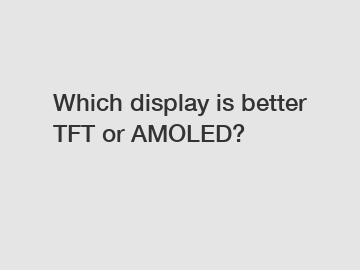Which display is better TFT or AMOLED?
When it comes to choosing the best display for your device, there are two main contenders in the market - TFT and AMOLED. Both have their own set of advantages and disadvantages, and it can be quite confusing for consumers to decide which one is better suited for their needs. In this blog post, we will discuss the differences between TFT and AMOLED displays, and offer some insights to help you make an informed decision.
Let's start with TFT displays. TFT stands for Thin Film Transistor, and it is a type of LCD display that uses a thin film transistor to control each pixel on the screen. This results in better image quality and faster response times compared to traditional LCD displays. TFT displays are known for their vibrant colors, high brightness levels, and wide viewing angles. They are also energy-efficient, consuming less power than other types of displays.
On the other hand, AMOLED stands for Active Matrix Organic Light Emitting Diode. This type of display uses organic compounds that emit light when an electric current is passed through them. AMOLED displays are known for their deep blacks, high contrast ratios, and vibrant colors. They also offer faster response times and better viewing angles compared to TFT displays. However, AMOLED displays tend to be more expensive to manufacture, which can translate to higher prices for consumers.

One of the key differences between TFT and AMOLED displays is the way they produce colors. TFT displays use a backlight to illuminate the screen, while AMOLED displays emit light directly from the pixels themselves. This results in more accurate colors and better contrast ratios on AMOLED displays. In addition, AMOLED displays do not require a backlight, which can lead to thinner and lighter devices.
Another factor to consider when choosing between TFT and AMOLED displays is the power consumption. TFT displays consume more power than AMOLED displays, especially when displaying bright colors or white backgrounds. This can have an impact on the battery life of your device, especially if you use it frequently for activities such as gaming or watching videos. AMOLED displays, on the other hand, are more energy-efficient and can help extend the battery life of your device.
When it comes to outdoor visibility, AMOLED displays have an edge over TFT displays. The high contrast ratios and deep blacks of AMOLED displays make it easier to view the screen in bright sunlight or outdoor settings. This can be particularly beneficial for users who spend a lot of time outdoors or use their devices in bright environments.
In terms of durability, TFT displays are generally more robust and less prone to burn-in compared to AMOLED displays. Burn-in is a phenomenon where certain images or icons become permanently imprinted on the screen over time, especially if they are displayed for extended periods. This can be a concern for users who use their devices for long hours or play games with static elements on the screen.
In conclusion, both TFT and AMOLED displays have their own strengths and weaknesses. TFT displays are known for their energy efficiency, vibrant colors, and wide viewing angles, while AMOLED displays offer deeper blacks, higher contrast ratios, and better outdoor visibility. Ultimately, the best display for you will depend on your personal preferences and usage habits. Whether you prioritize color accuracy, battery life, or outdoor visibility, there is a display technology that will suit your needs.
Are you interested in learning more about oled display for smart wearables, oled display for car center console, tft motorcycle display? Contact us today to secure an expert consultation!
131
0
0


Comments
All Comments (0)